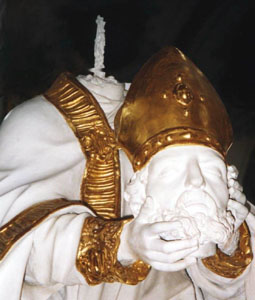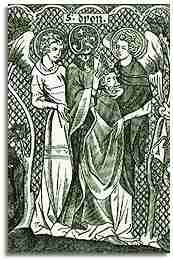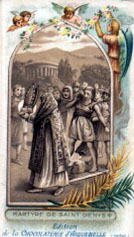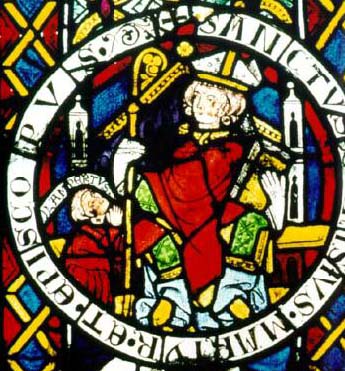
축일: 10월 9일
파리의 성 디오니시오 주교와 동료 순교자
San Dionigi e compagni Vescovo e martiri
ST.DENIS (Denys, Dionysius)
프랑스의 수호 성인.258년경 순교

프랑스의 수호 성인인 이 순교자는 원래 이탈리아 태생 주교였으나,
교황 파비안께서 250년에 선교사로서 골 지방으로 파견하셨다.
이때 6명의 주교들이 프랑스로 갔다고 한다.
투르의 성 그레고리오에 따르면, 디오니시오는 3세기 중엽 로마에서 프랑스로 왔다고 한다.
파리의 초대 주교가 되었고 그가 불과 몇 년을 선교하다가
자신의 사제인 성 루스띠꼬와 부제 성 엘레우테리오와 함께 체포되어 투옥되었다.
그곳에서 258년에 있었던 발레리아누스 황제의 박해 때에 두 동료 사제들과 함께 파리 근교에서 참수되었다
참수된 곳을 그 당시 사람들이 몽마르트르 곧 "순교자의 언덕"으로 불렀다. 이곳이 오늘의 몽마르뜨르 거리이다.
그들의 유해는 세느 강에 던져졌으나 곧 찾아냈으며, 파리의 북동쪽에 있는 마을로 그의 머리를 가져갔다고 한다.
6세기 초 성녀 제노베파는 디오니시오의 무덤 위에 대성당을 건축했다고한다.
이곳이 저 유명한 파리에 있는 성 디오니시오 대수도원 성당(쌩 드니의 베네딕토 수도원) 이 되었다.

우리는 그분의 생애에 대해서는 거의 아무것도 아는 것이 없지만
그에 대한 공경이 수세기 동안 교회 역사의 중요한 부분을 차지해 온 성인을 맞이했다.
우리는 이 성인이 그 당시의 사람들에게 새겨 놓은 깊은 인상은
뛰어나게 성스러운 그의 생활에서 연유한 것이 틀림없다고 결론지을 수 밖에 없다.
이러한 모든 경우에 근본적인 두 가지 요인이 있다.
하나는 위대한 인물이 그리스도를 위해서 자신의 생애를 바쳤으며 교회는 결코 그를 잊지 않는다는 것이고,
다른 하나는 하늘에 계신 우리 아버지께서 지니신 영원한 관심에 대한 인간의 상징이라는 것이다.

순교는 꿋꿋한 신앙에 의한 죽음으로
그리스도인의 죽음을 순수한 형태로 드러내는 한, 교회 본질의 일부이다.
한편 죽음으로도 꺾이지 않는 신앙은
모든 인간사의 반대 감정이 병존하는 속에 숨어 있는 것이다.
교회의 성덕은 순교를 통하여 순전히 주관적인 차원에 머무르지 않고
하느님의 은총에 따라 그것이 필요로 하는 눈에 보이는 표현을 얻는 것이다.
2세기라는 초창기부터
그리스도교 신앙이나 그리스도교 윤리 때문에 죽음을 받아들인 사람은 마르티르(Martyr)라 하여 존경했다.
이 증거자란 성서에 있는 말로서 예수 그리스도의 "가장 충실한 증거자"(묵시1,5; 3,14)라 한다.
(칼 라너, Theological Dictionary)

성 암브로시오 주교의 「시편 118편 주해」에서
(Semo 20,47-50: CSEL 62,467-469)
충실하고도 굳건한 증인이 되십시오
여러 종류의 박해가 있는 것처럼 여러 형태의 순교가 있습니다. 즉 여러 가지 방법으로 그리스도를 증언할 수 있습니다.
당신은 매일 매일 그리스도의 증인이 되고 있습니다. 당신이 정욕의 영으로 유혹받을 때,
다가오는 그리스도의 심판이 두려워 영혼과 육신의 정결을 간직한다면 그리스도를 위한 순교자, 그분의 증인이 됩니다.
당신이 탐욕의 영으로 미천한 사람의 소유물을 차지하고 싶거나 무방비한 과부의 권리를 침해하고 싶은 유혹을 받을 때,
하느님의 계명을 기억하여 어려운 사람에게 해를 끼치기보다 그를 도와주어야 한다고 판단 내린다면 그리스도의 증인이 됩니다.
이사야서의 다음 말씀처럼 그리스도께서는 당신의 증인들이 그렇게 하기를 원하십니다.
“억눌린 자를 풀어 주고 고아의 인권을 찾아 주며 과부를 두둔해 주어라. 오라, 와서 나와 시비를 가리자. 주께서 말씀하신다.”
당신이 또 교만의 영으로 유혹을 받을 때 불쌍한 이와 가난한 이를 보고서 그들을 가엾이 여겨, 교만보다 겸손을 더 높이 평가한다면
그리스도를 위한 순교자, 그분의 증인이 됩니다. 그때 당신은 단순히 말로써만이 아니라 행동으로 그리스도를 증언해 준 것 입니다.
복음의 계명을 지킴으로써 “예수 그리스도께서 사람의 몸으로 오셨다고 증언해 주는” 사람보다 더 믿음직한 증인이 있겠습니까?
그러나 말씀을 들어도 그것을 실행치 않는 사람은 그리스도를 부인하는 셈입니다.
그는 말로써 고백한다고 하지만 행동으로는 부인합니다. “그날에 많은 사람 이 나를 보고
’주님, 주님! 우리가 주님의 이름으로 예언을 하고 주님의 이름으로 마귀를 쫓아내고 또 주님의 이름으로 많은 기적을 행하지 않았습니까?’
하고 말할 때” 주님은 분명히 그들에게 “악한 일을 일삼는 자들아, 나에게서 물러가라.” 하고 말씀하실 것입니다,
따라서 참된 증인이란 예수 그리스도의 계명을 특히 행동의 증거로써 증언해주는 사람입니다.
매일 매일 은밀한 데에서 그리스도를 위한 순교자, 그분의 증인이 되고 주 예수를 고백하는 이들 이 얼마나 많습니까!
사도는 이러한 순교와 그리스도께 대한 충실한 증거를 알고 있었습니다.
그는 이렇게 말했습니다. “이것은 바로 우리의 자랑이고 우리 양심의 증거입니다.” 그러나 반대 경우의 사람들도 얼마나 많습니까?
그들은 외적으로는 그리스도를 고백하고 내적으로는 부인했습니다.
성서에 이런 말씀이 있습니다. “영이라고 다 믿지 마십시오. 그들의 열매를 보고 누구를 믿어야 하는지 알게 될 것입니다.”
그러므로 외부로부터 오는 박해에서 승리를 얻을 수 있도록 내부의 박해에서도 충실하고 굳건한 증인 곧 순교자가 되십시오.
내부의 박해에서도 권력을 쥔 무서운 임금이나 통치자나 판관들이 있습니다. 주께서 받으신 유혹에서 그 한 가지 예를 볼 수 있습니다.
어딘가 이런 말씀이 있습니다. “죄가 여러분의 죽을 몸에서 군림하지 못하게 하십시오.”
사람이여, 죄가 당신 안에서 군림한다면 당신은 당신의 왕이 되는 게 무엇인지 알 수 있습니다.
죄와 악행이 많으면 많을수록 거기에 따른 통치자도 그만큼 많아집니다. 우리는 이 통치자들 앞에 끌려 나아가 그들 앞에 서 있습니다.
이 통치자들은 많은 이들의 영혼 안에서 자기네의 재판석을 세웠습니다.
그러나 누가 그리스도를 고백한다면 이 통치자들을 즉시 굴복시키고 영혼의 옥좌로부터 쓰러뜨립니다.
실상 그리스도께서 이미 재판석을 세우신 영혼 안에 어떻게 마귀의 재판석이 그대로 남아 있을 수 있겠습니까?
*파리의 수호성녀 제노베파 축일:1월3일.게시판946번
*투르의 성 그레고리오 축일:11월17일
*성 암브로시오 주교 축일:12월7일.게시판790번
*아레오파고의 성 디오니시오 축일:10월3일.게시판1402번
☞http://home.catholic.or.kr/gnbbs/ncbbs.dll/chinchang

몽마르뜨 예수 성심 대성당 (Sacre Coeur de Montmarte)
몽 마르뜨르는 프랑스 파리 북동쪽에 있는 표고 130m의 작은 언덕으로 순교자의 언덕 (Mons Martyrum) 이라는 말에서 유래했다.
파리의 초대 주교였던 성인 디오니시오(St-Denis-쌩드니)가 이 산에서 순교하여 「순교자의 산」이라는 뜻으로
몽 데 마르뜨르」(Mont des Martyrs)로 불려 오다가 후에 「몽 마르뜨르」현재의 이름으로 통용되게 되었다고 한다.
몽마르뜨르 언덕의 정상에 위엄있게 서 있는 예수성심 성당은
인상적인 조각, 그림, 모자이크 장식 등이 참으로 정교하며, 천정의 정상까지 올라갈 수 있다.
1870년 독일과의 교전으로 시련을 격게 된 프랑스 국민들이 거국적으로 성금을 모아 1910년에 건립하였으며
거대한 백악(百堊)의 아름다운 예수 성심 대 성당이 정상에 세워져 파리의 명소가 되었다.

전주의 몽마르트 순교자 산
한국의 전주교구 중바위 치명자산 성지.
동서고금에 유래가 없는 동정부부 순교자.유중철(요한)과 이순이(루갈다)

♬15.salve regina - monastic chants-christdesert(Benedict)
DENIS
Also known as
Denys; Dionysius
Memorial
9 October
Profile
Missionary to Paris. First Bishop of Paris. His success roused the ire of local pagans, and he was imprisoned by Roman governor. Martyred in the persecutions of Valerius with Saint Rusticus and Saint Eleutherius, who may have been his deacons. Legends have grown up around his torture and death including one that has his body carrying his severed head some distance from his execution site. Saint Genevieve built a basilica over his grave. His feast was added to the Roman Calendar in 1568 by Pope Saint Pius V, though it had been celebrated since 800. One of the Fourteen Holy Helpers.
Died
beheaded c.258 at Montmarte (= mount of martyrs); his corpse was thrown in the Seine, but recovered and buried later that night by his converts
Patronage
against frenzy, against strife, France, headaches, Paris, possessed people
Additional Information
Google Directory
Representation
beheaded bishop carrying his severed head - the head sometimes wears its mitre, and there is often a vine growing over his neck
GENEVIEVE
Also known as
Genovefa
Memorial
3 January
Profile
When she was seven years old, Genevieve met Saint Germanus of Auxerre on his way to England. Germain befriended her because of her insistence on wanting to live her life for God, and prophesied her future sanctity. Took the veil at age 15. Prophesied invasions and disasters for Paris. Could read consciences and calm the possessed. When Paris was besieged by the Franks, she encouraged its defense, organized prayers for God’s protection of the city, and led an expedition for food to relieve the seige. Caused a church to be built on the tomb of Saint Denis. In 1129, the procession of her relics through Paris is believed to have ended an epidemic.
Born
422 at Nanterre near Paris, France
Died
500 at Paris, France
Canonized
Pre-Congregation
Patronage
disasters, fever, Paris, plague, WACs, women’s army corps
Representation
bread; candle; cattle; girl restoring eyesight to her mother; herd; keys; shepherdess holding a candle which the devil is trying to extinguish and angels are helping to protect; shepherdess with a coin suspended around her neck
San Dionigi e compagni Vescovo e martiri
9 ottobre - Memoria Facoltativa
sec. III
Secondo la tradizione, fu il primo vescovo di Parigi, inviato in Gallia dal Papa Fabiano nel 250. Subì il martirio insieme a Rustico ed Eleuterio. Le sue reliquie sono custodite nella Basilica che Santa Genoveffa fece erigere nel 495. Accanto ad essa nel secolo VII sorse la celebre abbazia che da lui prese il nome. (Mess. Rom.)
Etimologia: Dionigi = consacrato a Dioniso (è il dio Bacco)
Emblema: Bastone pastorale, Palma
S. Dionigi è citato in vari importanti documenti tutti datati intorno al V-VI secolo; come la ‘Vita di s. Genoveffa’ ove si dice che la santa verso il 475 costruì a Parigi la chiesa di s. Dionigi; lo storico-poeta Venanzio Fortunato, morto verso il 600, anch’egli annota nei suoi scritti la chiesa di s. Dionigi e un’altra esistente a Bordeaux; s. Gregorio di Tours (m. 594) nella sua ‘Historia Francorum’ racconta di Dionigi e il suo martirio.
Stranamente in questi antichi autori mancano notizie per i compagni di martirio e di apostolato di Dionigi vescovo, cioè Rustico prete ed Eleuterio diacono; i loro nomi compaiono per la prima volta nel secolo VI-VII nel ‘Martirologio Geronimiano’.
La prima ‘passio’ latina si ha nell’VIII secolo e posiziona al I secolo la venuta in Gallia di Dionigi e compagni, ma una seconda e terza ‘passio’ del IX sec. hanno creato un alone di leggenda intorno alla sua figura. Fu identificato con Dionigi l’Areopagita, convertito da s. Paolo e questa versione andò avanti per parecchio tempo, riportata peraltro in tanti documenti e codici; ma poi altri autorevoli testi e studi successivi hanno definitivamente divise le due figure, che si celebrano distintamente il 3 ottobre per l’Areopagita e il 9 ottobre per Dionigi di Parigi.
La versione più accreditata, lo indica come mandato da Roma insieme agli altri due compagni, ad evangelizzare nel III secolo, la Gallia, divenendo primo vescovo di Parigi che allora si chiamava Lutezia, organizzatore della prima comunità cristiana sulla Senna, e martire nel 270.
Resta il mistero del silenzio per tre secoli sulle figure di Eleuterio e Rustico, alcuni studiosi affermano che è usanza nel nominare una chiesa, di dire solo il nome del titolare principale; altri fanno l’ipotesi che Dionigi porta il nome del dio Dionisius che fra gli altri epiteti ha anche Eleutherius cioè Libero e inoltre esso era un dio che simboleggiava la natura, sempre percorrendo campi e foreste, quindi un nume rustico, da qui Rusticus.
Con la confusione che ha distinto la storia dei nomi dei santi più antichi, si può supporre che non di compagni si tratti, ma di aggettivi, questo spiegherebbe il silenzio così lungo.
Dionigi a causa delle leggende che l’hanno confuso con l’altro Dionigi l’Areopagita, si è portato con sé, tradizioni, culto e raffigurazioni, provenienti da quel periodo.
Così egli è raffigurato in tante chiese con statue, vetrate, bassorilievi, miniature, lezionari, pale d’altare, dipinti, in buona parte da solo, in vesti episcopali, spesso con la testa mozzata fra le mani; dopo l’VIII secolo è raffigurato anche insieme ad Eleuterio e Rustico.
L’iconografia è ricchissima, testimonianza della diffusione del culto a Parigi ed in tutta la Francia e poi nelle Colonie, essa rappresenta con dovizie di particolari, il processo davanti al governatore Sisinnio, il supplizio della graticola con le fiamme, la santa Comunione ricevuta da Gesù Cristo mentre era in carcere, soprattutto il martirio mediante decapitazione o rottura del cranio, avvenuta a Montmartre e con Dionigi che cammina da lì al luogo della sepoltura, con la testa portata da se stesso con le mani.
Il nome Dionigi e la variante francese Denis e Denise, è di ampia diffusione, mentre Dionisio e Dionisia è molto raro.
Autore: Antonio Borrelli
_______________________
Aggiunto il 1-Aug-2002
Letto da 4294 persone